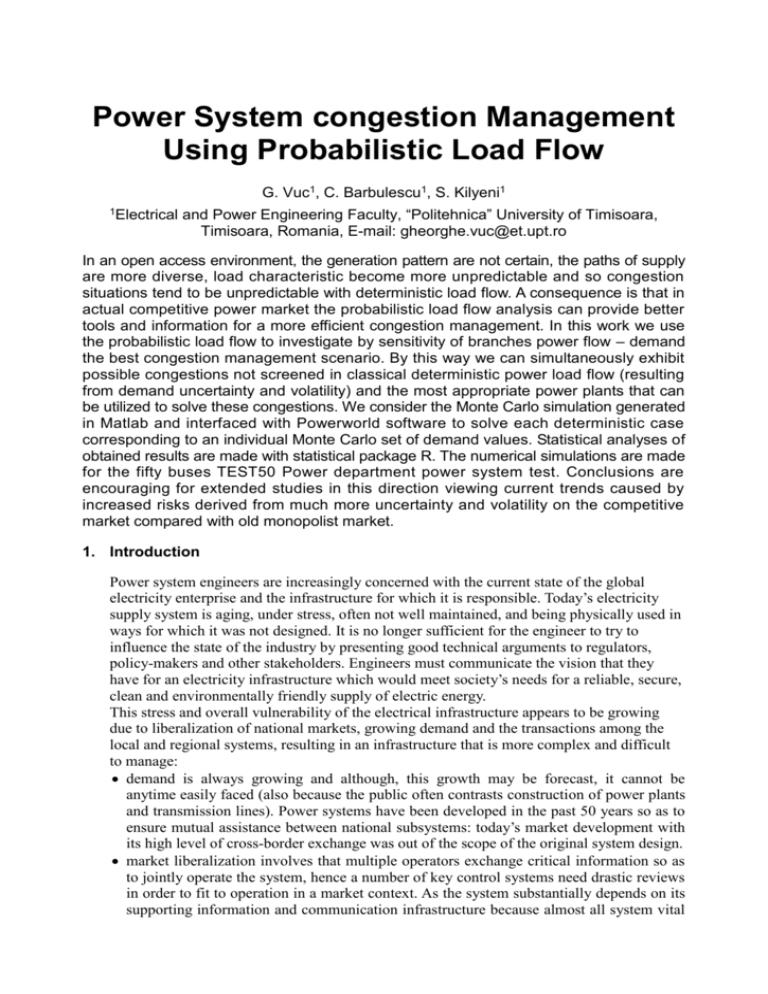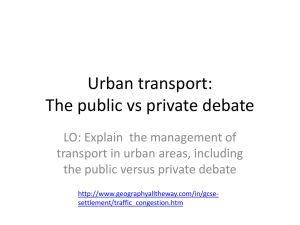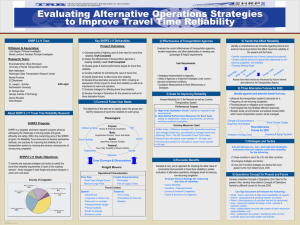Power System congestion Management Using Probabilistic Load Flow
advertisement

Power System congestion Management Using Probabilistic Load Flow G. Vuc1, C. Barbulescu1, S. Kilyeni1 1Electrical and Power Engineering Faculty, “Politehnica” University of Timisoara, Timisoara, Romania, E-mail: gheorghe.vuc@et.upt.ro In an open access environment, the generation pattern are not certain, the paths of supply are more diverse, load characteristic become more unpredictable and so congestion situations tend to be unpredictable with deterministic load flow. A consequence is that in actual competitive power market the probabilistic load flow analysis can provide better tools and information for a more efficient congestion management. In this work we use the probabilistic load flow to investigate by sensitivity of branches power flow – demand the best congestion management scenario. By this way we can simultaneously exhibit possible congestions not screened in classical deterministic power load flow (resulting from demand uncertainty and volatility) and the most appropriate power plants that can be utilized to solve these congestions. We consider the Monte Carlo simulation generated in Matlab and interfaced with Powerworld software to solve each deterministic case corresponding to an individual Monte Carlo set of demand values. Statistical analyses of obtained results are made with statistical package R. The numerical simulations are made for the fifty buses TEST50 Power department power system test. Conclusions are encouraging for extended studies in this direction viewing current trends caused by increased risks derived from much more uncertainty and volatility on the competitive market compared with old monopolist market. 1. Introduction Power system engineers are increasingly concerned with the current state of the global electricity enterprise and the infrastructure for which it is responsible. Today’s electricity supply system is aging, under stress, often not well maintained, and being physically used in ways for which it was not designed. It is no longer sufficient for the engineer to try to influence the state of the industry by presenting good technical arguments to regulators, policy-makers and other stakeholders. Engineers must communicate the vision that they have for an electricity infrastructure which would meet society’s needs for a reliable, secure, clean and environmentally friendly supply of electric energy. This stress and overall vulnerability of the electrical infrastructure appears to be growing due to liberalization of national markets, growing demand and the transactions among the local and regional systems, resulting in an infrastructure that is more complex and difficult to manage: demand is always growing and although, this growth may be forecast, it cannot be anytime easily faced (also because the public often contrasts construction of power plants and transmission lines). Power systems have been developed in the past 50 years so as to ensure mutual assistance between national subsystems: today’s market development with its high level of cross-border exchange was out of the scope of the original system design. market liberalization involves that multiple operators exchange critical information so as to jointly operate the system, hence a number of key control systems need drastic reviews in order to fit to operation in a market context. As the system substantially depends on its supporting information and communication infrastructure because almost all system vital functions are remotely controlled, an increased control systems complexity, as in turn raise system vulnerability, due both to accidental faults and malicious attacks. The general industry practice for security assessment has been to use a deterministic approach: the power system is designed and operated to withstand a set of contingencies referred to as “normal contingencies” selected on the basis that they have a significant likelihood of occurrence. This is usually referred to as the N-1 criterion because it examines the behaviour an N-component grid following the loss of any one of its major components. Load flow analysis is then applied to evaluate the resulting grid conditions. Power engineers need new instruments developed according to the situations created ready to analyze the power systems operating conditions. Such an instrument or method is called probabilistic load flow (PLF), which we are trying to present it in this paper. This new method of optimal power flow (OPF) can be successfully applied in the case of stochastic power systems, which are represented by the cases analyzed above and is specially designed for risk management. This succinct and partial overview clearly shows that electricity is indeed a very special case. The new breeze of competition which has blown such high hopes will gradually give way to the icy winds of reality. 2. Mathematical model For actual restructured power markets the locational marginal pricing appears as the best method to deal with the mixture of engineering and financial problems of optimal dispatch and open access to transmission network. This is done by solving an optimal problem, with marginal prices as part of solution. The objective function for such a problem is defined [2] as (1) OF CGi ( PGi ) CCi ( PCi ) CSB ( PSB ) PT (Sl Slmax ) in \ SB in \ SB ij i , jn ij where, CGi ( PGi ) is the generation hourly cost for bus i, CC ( PC ) is the cost of reducing electric i i power demand for bus i, CSB ( PSB ) is the generation cost for slack bus, and PT (Sl Slmax ) is ij ij the penalty cost of exceeding the MVA maxim limit of a branch. The constraints for active and reactive power are in \ NE PGi PNE in \ NE PCi P PGimin PGi PGimax ; (1a) i n PGi PCi U i Yij U j cos( i i ij ); i n (1b) (1c) (1d) (1e) (1f) (1g) QGi QCi U i Yij U j sin( i i ij ); (1h) min Gi QGi Q ; i n min Ci PCi P ; i n min Ci QCi Q ; i n min i Ui U ; i n max Gi Q P Q U max Ci max Ci max i in in in Pl ij Pl max ij ; Pl ij U i2 YLij cos Lij U i YLij U j cos( i j Lij ) tlmin tl tlmax (1i) (1j) when the load Pci is considered as probabilistic value, the problem become a probabilistic load flow problem more complex and more difficult to solve. In our work we considered the Monte Carlo simulation and an interface to Powerworld software to solve each deterministic case corresponding to Monte Carlo set of demand values. 3. Probabilistic power flow (PPF) study The load was considered as a probabilistic value with a normal Gauss distribution function: N ( , ) (2) with average value μ and standard deviation σ, as aleatory uncertainties, for which is possible to determine by observations the distribution function type and the characteristic parameters. Sources were accepted as non-aleatory uncertainties type and the network structure with simple contingencies. Our simulation was made with TEST50 buses test power system having the scheme presented in Fig. 1 [9]. Simulations were made in Powerworld 8, by changing in this view the actual load from external generated sets of load values. In order to get a much real significance for each simulation were used 1000 values sets externally generated. 3 2 3 .1 3 7 M VR6 .0 0 0 M W 1 8 4 .0 0 0 M W 9 6 .0 0 0 M VR S15 2 0 .6 7 4 O2 2 0 2 7 7 .1 7 7 S220 3 0 4 .9 5 4 O4 0 0 4 9 6 .9 6 1 6 8 0 .0 0 0 0 0 0 M W 5 0 0 .2 9 5 8 3 7 M VR C4 0 0 C1 5 3 3 9 9 .0 5 2 1 5 .6 4 0 8 2 4 kV 8 0 .0 0 0 M W 6 0 .0 0 0 M VR 2 3 1 .1 5 0 1 9 2 kV G2 2 0 2 2 2 .9 3 3 5 9 4 kV 7 1 .4 8 M W 5 2 .1 8 M VR 14 11 C2 2 0 1 3 5 .4 0 M W 3 0 0 .0 0 0 M W 1 8 5 .0 0 0 M VR 2 3 7 .0 0 0 M W 3 5 .0 0 0 M VR 1 .5 1 M W 2 7 .3 8 M VR 2 2 2 .1 7 5 2 4 7 kV C1 1 0 2 6 .3 9 M VR 17 1 1 5 .8 8 0 2 1 9 kV T2 2 0 F2 2 0 13 2 0 5 .2 8 8 J1 1 0 1 1 3 .8 0 1 3 8 4 kV 19 1 7 0 .0 0 0 M W 9 0 .0 0 0 M VR F1 0 3 2 .0 0 0 M W 1 0 .0 0 0 M VR 4 8 .4 8 M W 3 .3 9 M VR 7 5 .6 M VR 1 1 4 .2 3 1 9 9 5 kV K1 1 0 20 H2 2 0 2 2 1 .6 6 0 8 4 3 kV I2 2 0 2 2 0 .8 6 5 7 6 8 kV 15 16 2 2 .0 0 0 M W 4 .0 0 0 M VR 5 0 .0 0 0 0 0 0 M W 1 8 .9 4 1 0 0 0 M VR M110 24 H1 1 0 23 1 1 4 .1 4 5 6 6 8 kV I1 1 0 22 5 8 .0 0 0 M W D1 0 3 3 .0 0 0 M VR 1 0 .3 2 7 kV 4 3 5 .0 0 0 M W 8 .0 0 0 M VR 1 2 .0 0 0 M W 5 .0 0 0 M VR 1 1 5 .7 1 3 8 0 6 kV D1 1 0 1 1 5 .2 0 3 8 6 5 kV 18 L1 1 0 N1 1 0 1 1 3 .6 2 2 7 3 4 kV 8 3 5 .4 7 9 1 1 3 .9 6 7 2 7 0 kV 21 25 1 2 0 .0 0 0 M W R4 0 0 3 0 .0 0 0 M VR 2 2 .0 0 0 M VR 1 7 5 .0 0 0 M W 2 0 .0 0 0 M W 1 2 .0 0 0 M VR E1 1 0 2 4 .0 0 0 M W 1 0 .0 0 0 M VR 1 1 4 .8 4 4 4 6 0 kV 5 3 0 .8 9 M W 4 3 0 .0 0 0 M W 8 0 .0 0 0 M VR D2 2 0 12 5 2 2 6 .8 0 5 3 8 9 kV 1 0 6 .4 3 M VR B2 2 0 2 3 7 .4 9 9 4 3 5 kV 10 8 B1 5 1 5 .9 3 7 7 2 0 kV 2 0 .0 0 0 0 0 0 M W 1 0 .6 5 0 0 0 0 M VR 5 3 0 .0 0 0 M W 1 4 0 .0 0 0 M VR 8 .0 0 0 M W 6 .0 0 0 M VR 1 6 9 .0 7 3 3 1 8 M W -1 8 .2 5 8 0 0 5 M VR A4 0 0 B4 0 0 3 9 8 .8 4 0 3 6 3 kV 4 0 0 .1 8 5 1 2 0 kV 8 0 .0 0 0 M W 6 0 .0 0 0 M VR 2 1 0 0 .0 0 0 M VR 5 4 0 .0 0 0 M W 9 6 8 .0 0 0 0 0 0 M W 2 4 .7 5 0 0 0 0 kV 3 6 5 .1 4 7 7 3 6 M VR 7 5 .0 0 0 M W 6 0 .0 0 0 M VR P400 P220 2 3 1 .2 7 0 9 A2 2 0 2 3 1 .8 0 9 2 5 0 kV 1 2 4 .7 5 0 0 kV Q4 0 0 4 1 3 .7 1 0 7 A2 4 2 4 .0 2 4 P24 8 0 .0 0 0 M W 6 0 .0 0 0 M VR 8 2 5 .0 0 0 M W 4 2 0 .6 1 7 M VR P15 1 1 1 0 .4 4 3 3 5 9 M W 1 5 6 .0 0 0 M W 4 2 0 .0 2 3 2 8 5 M VR 5 0 .0 0 0 M VR 6 1 1 .2 6 0 V2 2 0 3 3 2 .9 3 0 3 1 1 .5 0 9 Q2 2 0 U2 2 0 2 1 6 .9 5 9 1 3 6 .8 5 9 Y1 1 0 Q1 1 0 1 6 1 .5 2 0 1 5 .6 6 8 1 4 8 .1 4 8 2 5 0 .0 0 0 M W 2 0 0 .6 6 8 M VR X1 1 0 1 1 4 .2 4 1 V1 1 0 Y1 0 3 1 6 .6 1 9 1 2 .5 9 2 W2 2 0 4 7 .6 M VR W2 4 3 2 .6 4 1 W1 1 0 1 6 2 .1 2 7 4 0 0 .0 0 0 M W 5 0 .0 0 0 M W 3 0 .0 0 0 M VR 2 3 3 .9 5 6 M VR 1 0 .1 6 0 V1 0 5 .0 0 0 M W 7 0 .0 0 0 M W 3 .0 0 0 M VR 4 4 .5 0 0 M VR W1 0 1 4 .7 8 2 2 0 .0 0 0 M W 2 1 0 .0 0 0 M W 1 5 .0 0 0 M VR 3 2 4 .7 7 6 M VR Figure 1: TEST 50 buses test power system. The results are to be interpreted for each element of test system (branch, generator or consumer) to establish the behaviour in real market context. Generators were considered with quadratic cost curves, rel. (3): C Pg A B Pg C Pg2 (3) with each curve coefficients presented in Table 1. Generator P 7-1 (G1) P 11-3 (G3) P 26-27 (G27) AGC YES YES YES A 200 300 100 B 20 40 10 C 0.02 0.025 0.01 Table 1: Generators with AGC cost curves coefficients Only the generators G1, G3 and G27 have the AGC on, so only these generators can be used to manage the congestion situations. In our work we considered that during the probabilistic load flow a possible congestion situation can be identified by the greater average generation cost, which can be also compare with the deterministic average MW cost, presented in Table 1. P 7-1 P 11-3 P 26-27 Total gen. Total gen. Average gen. (G1) (G3) (G27) cost [$/hour] P [MW] cost [$/MW] -1046.35 -680.0 -825.00 98,093 4,335 22.63 Table 2: Deterministic operating parameters Among all 1000 simulation cases it were identified as congestion situation 22, other 467 being only suspected of congestion and need further analysis. Some of congestion situations are showed in Table 3. P 7-1 P 11-3 P 26-27 Total gen. Total gen. Average gen. Results (G1) [MW] (G3) [MW] (G27) [MW] cost [$/hour] P [MW] cost [$/MW] analysis -769.94 -620.15 -892.40 98,103 4,325 22.7 Congestion -778.78 -628.63 -899.76 99,305 4,346 22.8 Congestion -756.64 -626.33 -901.80 98,220 4,332 22.7 Congestion -762.81 -629.52 -894.43 98,522 4,332 22.7 Congestion -815.47 -605.41 -896.78 99,456 4,355 22.8 Congestion -765.08 -620.24 -909.24 98,248 4,332 22.7 Congestion -780.66 -612.42 -900.24 98,262 4,332 22.7 Congestion -758.39 -622.95 -903.43 97,778 4,312 22.7 Congestion -841.02 -572.52 -906.20 98,751 4,354 22.7 Congestion -1068.92 -707.76 -898.14 121,749 4,723 25.8 Analysis -771.48 -644.56 -902.27 100,204 4,362 23.0 Congestion -751.16 -635.61 -911.11 98,796 4,342 22.8 Congestion -787.68 -627.23 -906.30 99,863 4,361 22.9 Congestion -798.95 -610.03 -908.23 99,317 4,359 22.8 Congestion Table 3: Possible congestion situations For the main parameters characterising the probabilistic load flow presented in Table 4, we identified 22 congestion cases, all being positive solved by redispachting generation in OPF, and other 467 cases to be futher analysed. Average: Standard deviation: Max: 98,578 7,209 121,749 4,363 22.56 120 1.04 4,723 25.78 Cases: Congestion 22 2.20% Need analysis 467 46.70% OK 511 51.10% Table 4: Probabilistic load flow characteristics The above figures show that a large number of cases tend to be out of the 95% confidence zone. This can be explained by different optimal dispatching for different load demand combinations. However, for the largest hourly generation cost this is caused by the positive congestion management (see Table 5). P 7-1 P 11-3 P 26-27 Total gen. Total gen. Average gen. Results (G1) [MW] (G3) [MW] (G27) [MW] cost [$/hour] P [MW] cost [$/MW] analysis -911.13 -486.55 -918.96 97,425 4,362 22.3 -771.48 -644.56 -902.27 100,204 4,362 23.0 Congestion -973.91 -432.33 -921.36 97,534 4,362 22.4 -938.07 -465.12 -905.89 97,328 4,361 22.3 -787.68 -627.23 -906.30 99,863 4,361 22.9 Congestion Table 5: Congestion positive management It can be view that despite of an initial 10% standard deviation rate to mean value proposed for individual load demand, the total load demand results in only about 3% standard deviation. However, the hourly generation cost shows a much greater standard deviation. The conclusion in such cases is that this greater deviation is generated by deviation from optimal generation cost imposed from congestion management corresponding to individual cases. This can be view in Table 4 that for almost equal total load demand the hourly generation cost gets significant different values as consequence of positive management of congestion situations. Figure 2: Relation between 15 -10 branch power flow and the adiacent active demand The most likely congestion situation is for the 15 – 10 branch. In competitive market it is possible to solve a congestion situation also by consumer contribution. A solution is need only when the positive management by generators redispatching is not possible. In our simulation we found that all congestion situations could be solve only by generators contribution. Anyway the Figure 2 shows that only a diminish of demand in bus 14 and / or an increase of bus 13 demand can contribute to solve a congestion situation on 15 – 10 branch. Figure 3: Mean / Error evolution for generator G1 versus branch 15 – 10 power flow For the most likely congestion situation on the 15 – 10 branch we see that a positive management by redispatching generators it is not possible without generator G1 contribution. It can be seen in Figure 3 a relation between 15 – 10 branch power flow and generator G1 active power. It can be see that a major influence of G1 active power appears in vicinity of extremes and have a variable influence depending on the demand change distribution on the network reflected by Monte Carlo simulation. Further investigation is needed to catch this in an algorithm for intelligent scenario of congestion management. 4. Conclusion Our work shows that are possible for really possible deviation from deterministic representation of load demand to get unexpected congestion situations that are not showed by a classical power flow analysis. The relations established by numerous (1000 to 5000) cases considered for the Monte Carlos simulation can show much more information for an intelligent management scenario in congestion situations. For the numeric simulations realised we can conclude that the TEST50 system test can manage positive all the congestions that appears in our simulation, the penalty term of objective function (1) being 0 in all cases, in presence of significant values of dispatching term of objective function. This work shows that probabilistic power flow can be a more useful tool in congestion management for actual competitive power market environment. In addition, we can conclude that more investigation in this direction is needed. The competitive market, with much more uncertainties than the monopolistic market, imposes a more elaborated analysis for power flow studies and the most important factor must be the more volatile characteristic of demand. In an open access environment, the generation pattern are not certain, the paths of supply are more diverse and future load characteristic become more unpredictable and congestion situations tend to be unpredictable with deterministic load flow. References [1] T. De la Torrre, et al., „Deregulation, Privatization, and Competition: Transmission Planning, Under Uncertainty”, IEEE Trans. Power Syst., vol. 14, pp. 160-165, May 1999. [2] M. Nemes, D. Paunescu, G. Vuc, “Analyzing The Impact Of Probabilistic Load On Systems Hourly Cost”, 1st International Conference on Modern Power Systems MPS 2006, November 2006, ClujNapoca, Romania. [3] M. Nemes, D. Paunescu, G. Vuc, “The Probabilistic Value Of Congestion And Competitiveness Of Electric Market”, WEC Regional Energy Forum – FOREN 2006, june 2006, s1-03-en. [4] Dondera, R. Popa, C. Velicescu, “Monte Carlo Simula¬tion Adequacy in Distributed Generation Systems”, IYCE Budapest 2007. [5] R. Popa, D. Dondera, C. Velicescu, “The Gram-Charlier Expansion in Power System Reliability Estimation”, IYCE Budapest 2007. [6] P. Kádár, “Seeking for the optimal market”, 4th Slovakian – Hungarian Joint Symposium on Applied Machine Intelligence, Herl’any, Slovakia January 20-21, 2006, proceedings, pp. 234-246. [7] C. Barbulescu, G. Vuc, S. Kilyeni, “Probabilistic Load Modelling Influences On The Load Flow. Case Study Test25 Test Power System” ”, IYCE Budapest 2007. [8] S. Kilyeni et al., 50-bus test power system (in Romanian), Power Systems International Conference, Bucharest, Romania, vol.5, paper 5.07, 1988.





